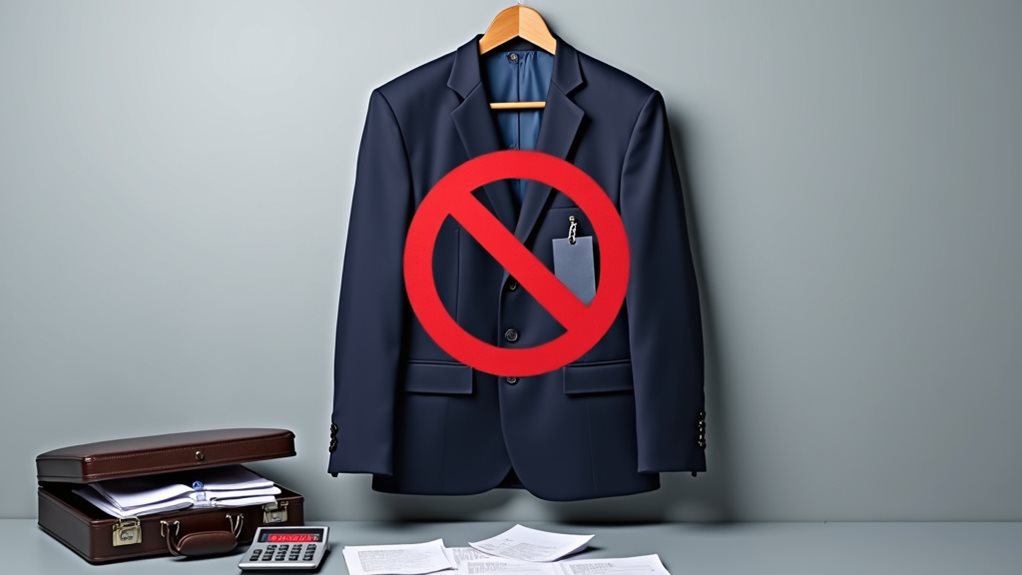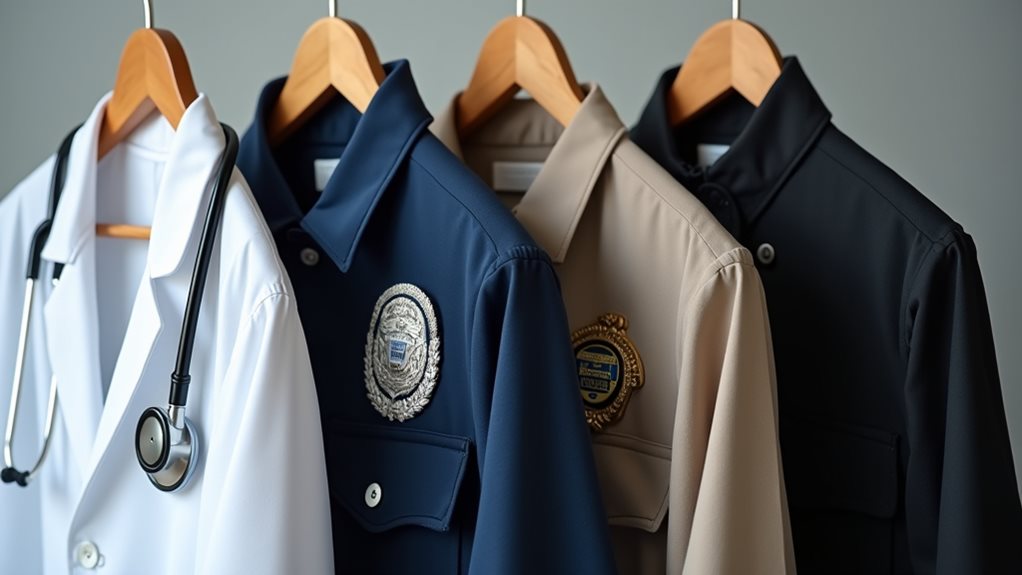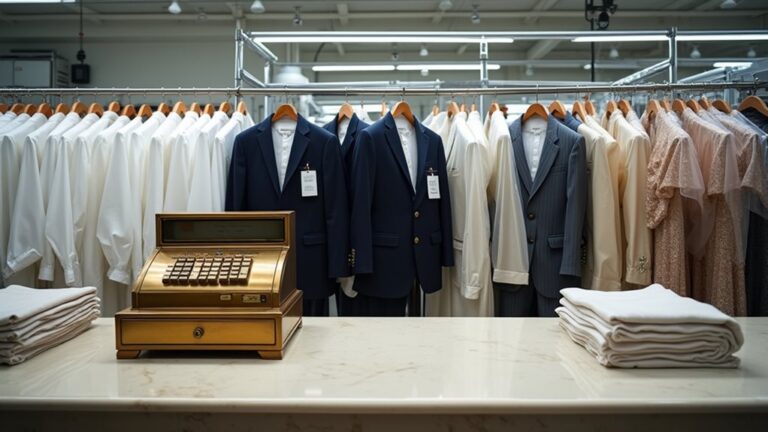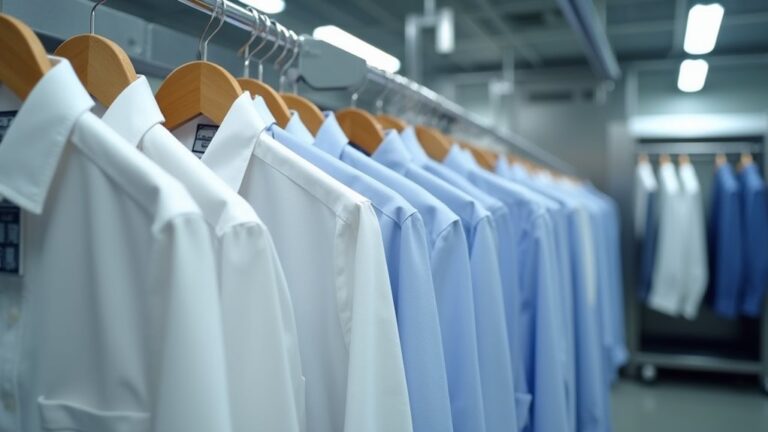You’ll likely be disappointed to learn that dry cleaning your business suits isn’t tax-deductible, even though maintaining that crisp professional look costs a fortune—trust me, I’ve been there with my own expensive wardrobe maintenance bills. The IRS requires a strict two-prong test: your employer must mandate specific clothing, and it must be completely unsuitable for everyday wear, which unfortunately excludes most business attire that doubles as regular clothing, though there’s more nuance to explore.
Understanding IRS Requirements for Clothing Deductions
While traversing the maze of tax deductions can feel like deciphering ancient hieroglyphics, understanding the IRS’s clothing deduction requirements doesn’t have to leave you scratching your head in confusion.
Here’s the reality check we all need: you can’t simply deduct your dry cleaning costs because you wear business attire to work. The IRS operates on a strict two-prong test that’ll make your head spin – your clothing must be required by your employer AND unsuitable for everyday wear.
The IRS’s two-prong clothing test is stricter than a drill sergeant – both requirements must be met simultaneously.
Both conditions have to be met, or you’re out of luck. That expensive suit you dry clean weekly? Unfortunately, it’s considered suitable for street wear, making those expenses non-deductible.
Examples of deductible items include protective gear, specialized uniforms with company logos, or costumes required for performers that serve no purpose outside the workplace.
Documentation becomes your best friend when claiming legitimate clothing deductions.
The Two-Prong Test for Work Attire Expenses

You’ll need to satisfy both conditions of the IRS Two-Prong Test before you can write off those dry cleaning bills, and trust me, I learned this the hard way when my accountant rejected my expensive suit cleaning receipts 😅.
The first prong requires that your employer actually mandates the clothing for your job, while the second prong examines whether you’d realistically wear these items during your weekend grocery runs or casual dinner dates.
Think of it like a strict bouncer at an exclusive club – your work attire must pass both checks, because failing either one means your dry cleaning expenses won’t make it past the IRS gates.
Even when claiming qualifying dry cleaning expenses, you’ll need to maintain detailed records showing the business purpose, date, and amount, since the burden of proof remains on you to demonstrate the legitimate business nature of the expense during an audit.
Required Employment Condition
Taxpayers must maintain detailed records including receipts and documentation showing the business necessity to support any deductible dry cleaning expenses.
Everyday Wear Suitability
Even though your employer demands specific attire, the IRS isn’t finished scrutinizing your wardrobe choices—they’re just getting warmed up with their relentless second condition.
The everyday wear suitability test cuts deep into clothing expenses deductibility, demanding your work attire can’t moonlight as suitable for ordinary street wear. I learned this lesson when my business suits failed the IRS criteria spectacularly—apparently looking professional everywhere disqualifies tax deductions entirely 😅.
The two-prong test requires both conditions simultaneously, meaning even mandatory work clothing loses deductibility if it’s versatile enough for weekend errands.
This harsh reality extends to dry cleaning costs too, since the IRS views maintenance expenses for everyday-suitable clothing as personal rather than business-related, resulting in complete non-deductibility. However, business owners can deduct dry cleaning expenses for legitimate business-related clothing that meets both prongs of the IRS test.
Why Business Suits Don’t Qualify for Deductions

You might think your sharp navy suit deserves a tax break since you wear it exclusively to impress clients, but here’s the reality check that once crushed my own deduction dreams: business suits fail the IRS’s everyday wear criteria because, let’s face it, you could stroll into any restaurant or social gathering without looking out of place.
The two-prong test becomes your nemesis when that same professional attire shifts seamlessly from boardroom to dinner date, making it unsuitable for deductions regardless of how work-specific you believe its purpose to be.
Even though I learned this lesson the hard way during my first audit, understanding that conventional business wear simply doesn’t meet the “not suitable for ordinary street use” requirement will save you from the disappointment of rejected deductions 📝.
While your everyday business attire won’t qualify, expenses for specialized work garments like uniforms, safety gear, and distinctive professional clothing required by your employer may actually be eligible for tax deductions.
IRS Two-Prong Test
When the IRS created their two-prong test for clothing deductions, they fundamentally built a fortress around business suits that most of us can’t breach, no matter how desperately we’d love to write off those hefty dry cleaning bills.
This IRS Two-Prong Test creates specific hurdles for clothing expenses, and understanding these employment requirements can save you from costly mistakes:
- Your employer must require the specific clothing – not merely suggest professional business attire, but actually mandate it.
- The clothing can’t be suitable for everyday wear – which immediately disqualifies most suits and professional wardrobe pieces.
- Both conditions must be met simultaneously – failing either prong makes your dry cleaning costs non-deductible.
Tax professionals consistently see clients stumble here because business attire feels work-specific, yet the tax implications remain clear: your sharp suits simply don’t qualify. 💼
The IRS considers personal expenses any clothing that could be worn outside of work, regardless of whether you wear these items primarily for business purposes.
Everyday Wear Criteria
Although most taxpayers assume their expensive business suits should qualify for deductions since they’re “work clothes,” the IRS takes a surprisingly broad view of what constitutes everyday wear.
Unfortunately for our wallets, those sharp blazers and fitted pants fall squarely into that category.
Here’s where the everyday wear criteria gets tricky: even if you only wear your business suits to work and never touch them otherwise, they’re still considered appropriate for general public use under IRS regulations.
The agency doesn’t care that you personally reserve them for employment purposes, because they could theoretically be worn to dinner, social events, or casual outings.
This broad interpretation means your dry cleaning and upkeep expenses won’t qualify as clothing deductions, regardless of how necessary for employment they feel.
However, self-employed individuals may have different options for claiming legitimate work-related clothing expenses compared to traditional employees, making it essential to understand which category applies to your tax situation.
Dry Cleaning Costs and Maintenance Expenses

Understanding dry cleaning costs and maintenance expenses can feel like traversing a maze blindfolded, especially since the tax environment shifted dramatically in recent years.
You’re probably wondering if those mounting bills from keeping your work wardrobe crisp can provide any tax relief 💸.
Here’s what you need to know about claiming these expenses:
- Self-employed individuals still have opportunities to deduct dry cleaning costs under IRS criteria, provided the clothing serves work purposes exclusively and isn’t suitable for everyday wear.
- Documentation becomes your lifeline – keep every receipt, invoice, and proof of purchase for clothing maintenance expenses that might qualify as eligible deductions.
- State tax returns may offer relief even when federal deductions aren’t available, so research your local regulations beyond employer requirements.
- Consulting with tax professionals ensures you’re maximizing legitimate deductions while staying compliant with current IRS regulations and avoiding potential audit complications.
Examples of Qualifying Work Clothing

Since steering through the murky waters of qualifying work clothing can feel like deciphering ancient hieroglyphics, let me share some clear-cut examples that’ll help you distinguish between what the IRS considers legitimate work attire versus your regular wardrobe.
Nurse scrubs, police uniforms, and pilot uniforms are slam-dunks for tax deductions because they’re required for employment and completely unsuitable for everyday wear.
Protective gear like hard hats, safety goggles, and steel-toed boots also qualify since you wouldn’t exactly wear them to brunch 😊.
Performers can deduct the cost of costumes, while clothing with business logos counts only if worn exclusively for work.
The key is meeting IRS guidelines: work-required and everyday-inappropriate.
Healthcare workers can also deduct dry cleaning costs for their specialized safety gear and required uniforms since these items serve essential workplace functions and cannot reasonably be worn in personal settings.
State Tax Rules Vs Federal Regulations

While federal tax laws might’ve slammed the door on employee dry cleaning deductions until 2026, your state could be rolling out the welcome mat with completely different rules that’ll make your accountant do a little happy dance.
Here’s what you need to know about traversing this maze:
- Check local regulations carefully – Your state tax rules might allow dry cleaning expenses for work attire even when federal regulations don’t, creating unexpected tax savings opportunities that most people miss.
- Self-employed individuals often win – If you meet qualifying criteria, your documentation of dry cleaning costs could reveal deductions on state returns regardless of federal limitations.
- Business owners have advantages – Companies can frequently claim these expenses on state filings, offering deductibility benefits that employees can’t access federally.




